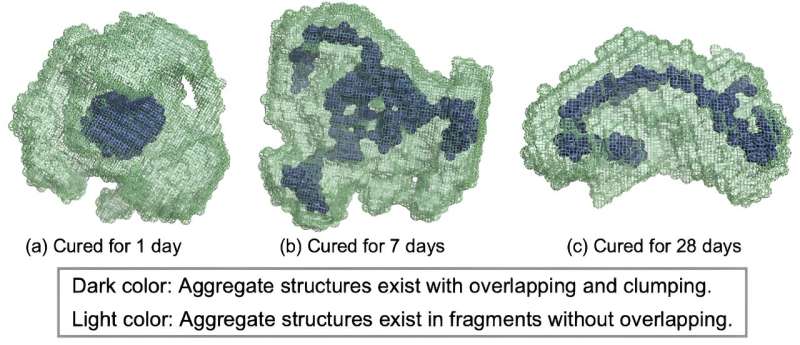This article has been reviewed according to Science X's editorial process and policies. Editors have highlighted the following attributes while ensuring the content's credibility:
fact-checked
trusted source
proofread
Understanding the strength development mechanism of chemically treated sandy soil

Chemical injection is a process that enhances sand strength and its water-sealing capacity, making sandy soil suitable for various applications in construction. However, a unified understanding of how this process results in increased strength remains elusive. Some studies in the past have suggested that chemical injection separates soil particles, which causes volume expansion.
This creates pockets of vacuum, resulting in "negative pressure," which pulls soil particles together and strengthens it. Increased tensile strength (which determines the load the soil can endure) is also thought to influence this behavior. Other studies have proposed that shrinkage of hydrogels (water-retaining polymeric structures) leads to soil particle compression and confinement, imparting strength to the soil. However, there is still a lack of clear understanding of the underlying mechanism behind the strength development of sandy soils.
Now, a team of scientists from Japan, led by Professor Shinya Inazumi from the Department of Civil Engineering at Shibaura Institute of Technology, has conducted a thorough investigation into the behavior of chemically injected sandy soil. Talking about the motivation behind this study, Prof. Inazumi says, "We were driven by a passion for sustainable development and the desire to contribute to safer and more efficient construction practices, particularly in the context of climate change and increasing urbanization."
Additionally, the researchers were also motivated by the goal of advancing geotechnical engineering, with the hope that it can have implications for public safety by enabling the development of technologies that mitigate the risk of natural disasters. Their work was published in the journal Gels.
In this study, the researchers first chemically injected sand-gel and hydrogel mixtures with an acidic solution and conducted various tests. This included the consolidation drainage triaxial compression tests, which isolate and measure the "cohesive strength" and the "angle of internal friction" in chemically enhanced soils. This testing method was chosen for its ability to provide accurate insights into soil behavior under static conditions, which is crucial for the safety and reliability of construction soil.
Additional techniques for mechanistic and structural analysis included unconfined compression tests, small-angle X-ray scattering, volume shrinkage studies, and theoretical modeling. Notably, this study marks the first instance of independent examination of the effects of dilatancy and hydrogel shrinkage on soil strength development. This distinction holds significance for the field, offering the potential to guide more targeted and efficient soil treatment methods.
The experiments revealed that the enhancement of strength in chemically treated sandy soil can be attributed to increased cohesion and the internal friction angle of the soil particles. Moreover, this improvement exhibits no long-term strength loss, and interestingly, the initial weakness of untreated sandy soil can be traced back to the hydrogel itself.
This understanding of hydrogels at the molecular level holds immense potential in civil engineering and environmental management. For example, this breakthrough can be used in earthquake-prone regions to enhance building safety, impart seismic resilience, and diminish soil liquefaction risks. Furthermore, flood-prone areas also stand to benefit from this new understanding as the water-sealing properties of these treated soils can mitigate floods and safeguard human settlements and agriculture.
In the long term, this technology can also protect coastal communities against rising sea levels, storm surges, and saltwater intrusion.
By stabilizing soil and increasing its water retention capacity, the present work yields numerous advantages across various other domains as well. This includes land reclamation, which is crucial for global food security, and pollution mitigation, which is important for curbing leaching into water bodies from landfills. Furthermore, it can also enhance the structural durability of civic infrastructure and ensure mining safety by preventing landslides.
As Prof. Inazumi explains, "Our research promises to fill critical knowledge gaps in soil treatment, which can be translated into more efficient and durable construction practices, and ultimately benefit a wide range of industries."
More information: Toshiyuki Motohashi et al, Strength Assessment of Water–Glass Sand Mixtures, Gels (2023). DOI: 10.3390/gels9110850




















